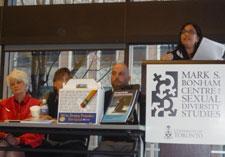Initial results from the first national survey on homophobia and transphobia in Canada’s schools suggest three-quarters of queer students and close to 90 percent of trans students feel unsafe in their schools, leading many to skip classes altogether.
“The biggest finding that comes from this report really is that homophobic and transphobic bullying is really neither rare nor harmless,” said Tracey Peter, coinvestigator for the survey and an assistant professor of sociology at the University of Manitoba, at a panel discussion of the findings on Apr 1. “I think we kinda knew this at the onset but now we have empirical, statistical information.”
The survey, launched by queer lobby group Egale Canada in 2007, was administered online and is still ongoing through in-class sessions in participating school districts across the country. Although there have been nearly 2,500 respondents so far, the phase one report only deals with some 700 responses that came from the online component.
“We wanted to get some results out at this point and phase two is still going on,” says Catherine Taylor, the study’s principal investigator and a professor in the faculty of education at the University of Winnipeg.
Taylor adds that it makes more sense to analyze the two sets of data separately because phase one and two involve “very different populations.” Phase one consists primarily of queer students and children of queer parents, plus “some straight kids who are interested in the cause” who found out about the online survey through promotion and by word of mouth.
“Phase two will consist of a general population in the schools so it’ll be mostly straight kids with the minority of LGBTQ kids,” says Taylor.
Taylor says that phase two, expected out later this year, will consider the differences between Catholic public schools with other public schools, look more closely at the experiences of trans students and children of queer parents, and also factor race and ethnicity into the findings.
Results from phase one of the survey found that queer students who attended schools with explicit antihomophobia policies and/or gay-straight alliances (GSAs) felt safer and more accepted. The report recommends that all schools implement explicit policies and make them known to students and staff and that school administrations support the formation of GSAs.
“It really starts at the government, the district and the school level, right down to the GSAs in schools,” says Peter.
Taylor says that although the survey was able to correlate students’ feelings of being unsafe with skipped classes, there wasn’t enough information in phase one on dropout rates to draw conclusions.
“It is a big concern and we didn’t have any significant findings on that question,” she says.
The study did not ask students about feelings of suicide related to homophobic or transphobic bullying.
“We talked about [including the question] but decided not to just because of the need to be really careful about how studies are debriefed when they ask super upsetting questions,” says Taylor. “We couldn’t be 100 percent sure that every student that filled out the survey would have been… encouraged to talk to a supportive adult afterward if they were feeling upset. We wouldn’t be entirely sure they’d know who to talk to or how get in touch with a crisis line.”
Much of the discussion at the Apr 1 event, which drew approximately 450 attendees, involved teachers’ roles in making schools into queer-positive spaces.
“We need to be able to say, ‘Yes, we’re training teachers and they need to know how to respond to students when they say, “That’s so gay” or “You fag” or whatever it is that they’re saying,'” said panelist Amy Gottlieb, a teacher at Victoria Park Collegiate and sponsor for that school’s Anti-Homophobia Allaince. “We need to know how to respond to that and we need to be accountable to it…. But we need to go way beyond that and that going beyond means that it needs to be integrated into the curriculum that all teachers are to teach in the classroom, elementary and secondary.”
SURVEY SAYS…
* One in four queer students reported physical harassment in connection to their sexuality while two in five trans students and one in five queer students reported physical harassment in connection to their gender expression
* Six out of 10 queer students reported being verbally harassed in connection to their sexual orientation while nine out of 10 trans students reported being verbally harassed about their gender expression
* Three-quarters of all respondents reported hearing expressions like “That’s so gay” on a daily basis while half heard homophobic slurs on a daily basis
* Three-quarters of queer students and 95 percent of trans students feel unsafe at school compared to one-fifth of straight respondents.

 Why you can trust Xtra
Why you can trust Xtra


